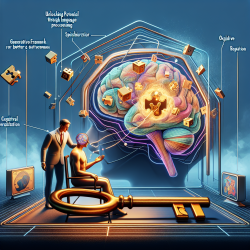Introduction
As practitioners in the field of speech-language pathology, we are constantly seeking ways to enhance our understanding and treatment approaches for individuals with language impairments. A recent study titled A Hierarchical Generative Framework of Language Processing: Linking Language Perception, Interpretation, and Production Abnormalities in Schizophrenia provides a groundbreaking perspective on language dysfunction in schizophrenia. This research offers valuable insights into how disruptions in language processing can be understood and addressed, ultimately improving therapeutic outcomes for our clients.
The Generative Framework: A New Perspective
The study by Brown and Kuperberg (2015) introduces a hierarchical generative framework of language processing, which links language perception, interpretation, and production abnormalities in schizophrenia. This framework suggests that language comprehension and production involve internal generative circuits that propagate probabilistic predictions to perceptual cortices. These predictions are updated based on prediction error signals as new inputs are encountered.
In schizophrenia, disruptions in these circuits can compromise communicative abilities by reducing the efficiency and robustness of both high-level language processing and low-level speech perception. This disruption may contribute to thought-disordered speech and false perceptual inferences, such as auditory verbal hallucinations (AVHs).
Implications for Practitioners
Understanding the generative framework of language processing offers several implications for practitioners:
- Holistic Approach: By considering both high-level semantic processing and low-level speech perception, practitioners can adopt a more holistic approach to language interventions in schizophrenia.
- Targeted Interventions: Identifying disruptions in generative circuits can help tailor interventions to address specific language processing deficits, potentially improving treatment efficacy.
- Future Research: The framework suggests productive avenues for future research, including exploring cognitive rehabilitation strategies that focus on enhancing generative circuits.
Encouraging Further Research
While the generative framework provides a novel understanding of language dysfunction in schizophrenia, it also highlights the need for further research. Practitioners are encouraged to explore how this framework can be applied to other language disorders and to investigate the potential for cognitive rehabilitation strategies that target generative circuits.
Conclusion
The insights from this research offer a promising direction for improving language interventions in schizophrenia. By understanding the underlying mechanisms of language processing abnormalities, practitioners can develop more effective strategies to support individuals with schizophrenia in achieving better communicative outcomes.
To read the original research paper, please follow this link: A Hierarchical Generative Framework of Language Processing: Linking Language Perception, Interpretation, and Production Abnormalities in Schizophrenia.










